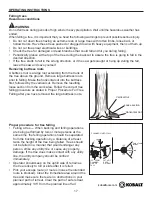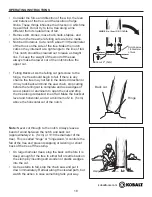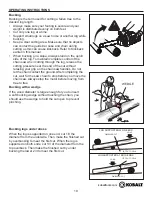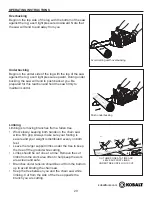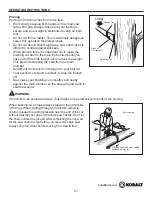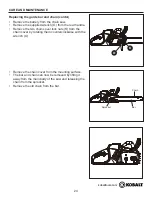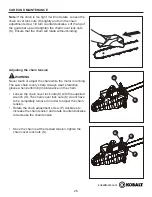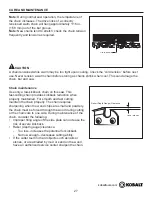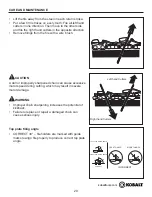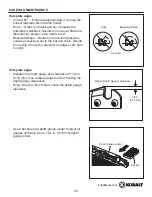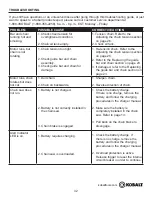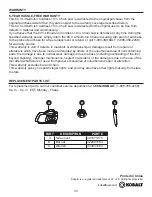
kobalttools.com
18
OPERATING INSTRUCTIONS
• Felling Backcut. As the felling cut gets close to the
hinge, the tree should begin to fall. If there is any
chance the tree may not fall in the desired direction or
it may rock back and bind the saw chain, stop cutting
before the felling cut is complete and use wedges of
wood, plastic or aluminum to open the cut and drop
the tree along its desired line of fall. Make the backcut
level and horizontal, and at a minimum of 2 in. (5 cm)
above the horizontal cut of the notch.
• Consider the force and direction of the wind, the lean
and balance of the tree, and the location of large
limbs. These things influence the direction in which the
tree will fall. Do not try to fell a tree along a line
different from its natural line of fall.
• Remove dirt, stones, loose bark, nails, staples, and
wire from the tree where felling cuts are to be made.
• Notched Undercut. Cut a notch about 1/3 the diameter
of the trunk on the side of the tree. Make the notch
cuts so they intersect at a right angle to the line of fall.
This notch should be cleaned out to leave a straight
line. To keep the weight of the wood off the saw,
always make the lower cut of the notch before the
upper cut.
Note: Never cut through to the notch. Always leave a
band of wood between the notch and back cut
(approximately 2 in. (5 cm) or 1/10 the diameter of the
tree). This is called “hinge” or “hingewood.” It controls the
fall of the tree and prevents slipping or twisting or shoot
back of the tree off the stump.
• On large diameter trees, stop the back cut before it is
deep enough for the tree to either fall or settle back on
the stump by inserting soft wooden or plastic wedges
into the cut.
• As tree starts to fall, stop the chain saw and put it
down immediately. Retreat along the cleared path, but
watch the action in case something falls your way.
HINGE 2 in. (5 cm) OR 1/10 DIA
Back cut 2" (5cm)
Notch Approx.
1/3 Diameter
of trunk
Back cut
Hinge
Wedge














